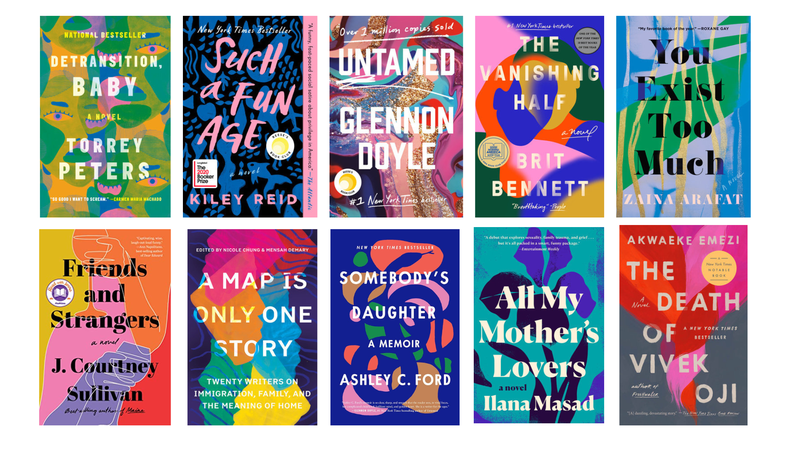BROOKE GLADSTONE Publishing is flush with fluctuating tech trends and taste, and that market mutability prompts big publishers like big film studios to play it safe. Which helps explain why if you walked into a bookstore in the last couple of years, you may have noticed that a lot of covers share a certain aesthetic. With some observers across the Internet have dubbed the book Blob. Actually, they're blobs of various bright hues and contours, beckoning abstractly behind the title.
MARGOT BOYER-DRY Cute, splashy, asymmetrical shapes on things. Bright colors all kind of smushed together.
BROOKE GLADSTONE Journalist and culture critic Margot Boyer-Dry wrote a piece in 2019 for Vulture called Welcome to the Bold and Blockie Instagram Era of Book Covers.
MARGOT BOYER-DRY I saw someone carrying a copy of Meg Wallace's The Female Persuasion, and it's a really striking cover. It's got these diagonal rainbow stripes, and then the title is in this bold, blocky white. I started noticing similar aesthetics on book covers pretty much everywhere. Really bright, splashy backgrounds. And just this fat text.
BROOKE GLADSTONE The trends in cover design reflect changes in fashion, most likely inspired by need. Today's covers need to inform and entice readers in physical bookstores and on digital apps where they show up as teeny, tiny thumbnails. Boyer-Dry found in her reporting that the bright, Instagram worthy book covers she was seeing in 2019, which later evolved into today's Blobs, came out of Riverhead Books, a penguin Random House imprint where Helen Giantess is the art director.
MARGOT BOYER-DRY And the way that she explains it is that a book needs to render well in every environment. If books are straddling digital and physical space, they need to work in both.
BROOKE GLADSTONE So if your eyeballs are burning from staring at all those neon jackets, you'll be glad to know that some of the newest hot fiction is leaning into a cooler, moodier palette.
MARGOT BOYER-DRY Look at the covers of Sea of Tranquility by Emily St John Mendel or Young Mungo by Douglas Stewart or How High We Go in the Dark by Sequoia Nagamatsu. These covers are so different from the blocky, splashy thing or the blob thing in that there's intrigue. Nothing is screaming at you here. It's kind of inviting you to be quiet and take a moment with the cover, which might not draw your eye as readily from across the room or a screen. But I think in its distinction from the aesthetic that's otherwise kind of dominating does set itself apart.
BROOKE GLADSTONE Back in the 1930s, the so-called father of spin, Edward Bernays, Sigmund Freud's nephew and a marketing genius, had a brilliant idea. He was doing work for a publishing consortium when the stock market crashed to keep the people buying books – he focused on the shelves. Where there are bookshelves. He is quoted as saying. There will be books. Bernays got boldface names to install bookshelves in their homes. House and Garden magazines began to feature homes with built in bookshelves as signifiers of class. And voila. The manipulative marketer gave rise to the personal bookshelf. As a mark of education, taste and cultural cachet for the masses. Fast forward to today when cable news hosts do countless Zoom interviews with experts on everything from vaccines to climate change to the Constitution. Celebrities have book stylists to make sure their books don't tell on them. More than ever books are signature accessories that you can if you wish, buy by the color or by the yard. But I wouldn't advise it. People will notice, in the words of the brilliant Twitter account called Bookcase Credibility, which hilariously rates the contents of the bookshelves of big shots. What you say is not as important as the bookcase behind you.


